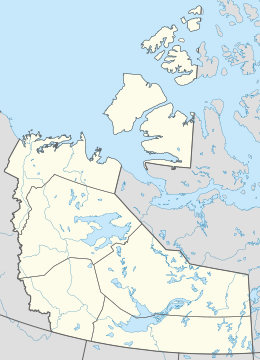Baillie Islands
| Geography | |
|---|---|
| Coordinates | 70°35′00″N 128°10′10″W / 70.58333°N 128.16944°W[1] |
| Adjacent to | Beaufort Sea |
| Total islands | 3 |
| Administration | |
Canada | |
| Territory | Northwest Territories |
| Region | Inuvik |
The Baillie Islands (Inuvialuktun: Utkraluk)[2] are located off the north coast of Cape Bathurst in the Northwest Territories, Canada.[3] The group consists of one large and two smaller islands,[4] and are named after George Baillie, Agent-General of the Crown Colonies.[5]
The islands formed part of the area used by the Avvaqmiut, who are a branch of the Inuvialuit (Mackenzie Inuit).[6]
Geography
[edit]The northernmost and largest island of the Baillie Islands is about 16 km (10 mi) long and is quite low. Observation Point, its northern extremity, is about 12 m (40 ft) high. Two sandspits, with a small cove between them, extend in a southerly direction from the southeastern end of the island.[4]
A rare endemic plant known as hairy rockcress or hairy braya (Braya pilosa, genus Braya of family Brassicaceae) is known to grow in five locations on the Baillie Islands as well as the nearby Cape Bathurst. The plant is listed by the Northwest Territories Species at Risk Committee as threatened and by the Committee on the Status of Endangered Wildlife in Canada as endangered.[7][8]
History
[edit]The first European to visit the area was John Richardson in 1826, who also named it.[9] It was again visited by Richardson and John Rae, while searching the Northwest Passage for Franklin's lost expedition.[6] For many years, the island was a summer meeting point for whalers, as well as traditional fishing grounds.[10]
In 1915, the Hudson's Bay Company (HBC) established a trading post on the island. While the post was being set up, it was visited by competing trader Christian Theodore Pedersen.[11] By the 1920s, the Royal Canadian Mounted Police (RCMP) had established a detachment on the island.[12] It was at Baillie Island, in 1928, after returning from Cambridge Bay that Inspector Kemp, the Commanding Officer for the Western Arctic, appointed Henry Larsen captain of the St. Roch.[13]
In 1925, Inuvialuk artist Agnes Nanogak was born on the Baillie Islands to Natkutsiak (Billy Banksland) and Topsy Ekiona.[14]
In 1939, the HBC post was moved to the RCMP buildings at Maitland Point, because Baillie Island was eroding. The post was then renamed to Maitland Point. It closed in 1941.[10]
References
[edit]- ^ "Baillie Islands". Geographical Names Data Base. Natural Resources Canada.
- ^ Issenman, Betty. Sinews of Survival: The living legacy of Inuit clothing. UBC Press, 1997. pp252-254
- ^ "Baillie Islands". Geographical Names Data Base. Natural Resources Canada.
- ^ a b Georgetown University, Office of the Chief of Naval Operations (1956). Canadian North. United States: Technical Assistant to Chief of Naval Operations for Polar Projects (OP-O3A3). p. 381. Retrieved 31 January 2025.
 This article incorporates text from this source, which is in the public domain.
This article incorporates text from this source, which is in the public domain.
- ^ Taylor, Isaac (1896). Names and Their Histories: Alphabetically Arranged as a Handbook of Historical Geography and Topographical Nomenclature. United Kingdom: Macmillan. p. 58. ISBN 978-0-8274-3009-9.
 This article incorporates text from this source, which is in the public domain.
This article incorporates text from this source, which is in the public domain.
- ^ a b "Archaeology of the Western Arctic Coast". Archived from the original on 14 July 2011. Retrieved 5 September 2009.
- ^ Hairy Braya NWT Species Status Report
- ^ COSEWIC Assessment and Status Report on the Hairy Braya Braya pilosa in Canada
- ^ Franklin, John (1828). Narrative of a second expedition to the shores of the Polar sea in the years 1825, 1826 and 1827, by John Franklin,... including an account of the progress of a detachment to the Eastward, by John Richardson. London: J. Murray.
John Franklin 1826.
- ^ a b "Hudson's Bay Company: Baillie Island". pam.minisisinc.com. Archives of Manitoba - Keystone Archives Descriptive Database. Retrieved 28 January 2025.
- ^ Hudson's Bay Company Archived 20 September 2008 at the Wayback Machine at the Kitikmeot Heritage Society
- ^ "Christian Klengenberg - More Suspicions". Archived from the original on 27 February 2012. Retrieved 5 September 2009.
- ^ Dangerous Passage: Issues in the Arctic ISBN 978-1-897045-13-8
- ^ "Nanogak, Agnes". Canadian Women Artists History Initiative. Concordia University. Retrieved 17 March 2025.

